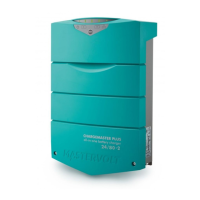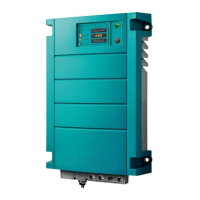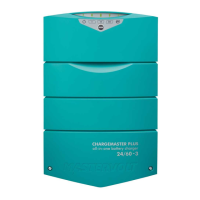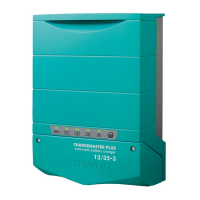OPERATION
EN / Chargemaster 12/25-3, 24-12-3 / February 2010 7
The bulk phase is followed by the ABSORPTION phase.
Absorption charging starts when the voltage on the
batteries has reached 14.4V (12V models) / 28.8V (24V
models) at 25°C / 77°F, and ends when the battery is
completely full. Battery voltage remains constant at 14.25V
(12V models) / 28.5V (24V models) at 25°C / 77°F
throughout this stage, and the charge current depends on
the degree to which the battery was initially discharged,
the battery type, the ambient temperature, and so on. With
a wet cell battery this stage lasts approx. four hours, with
gel and AGM around three. Once the battery is 100% full,
the Chargemaster automatically switches over to the float
phase. During the FLOAT phase the Chargemaster
switches to 13.25V (12V models) or 26.5V (24V models) at
25°C / 77°F and stabilises this voltage to maintain the
batteries in an optimum condition. Connected DC-loads
are powered directly by the charger. If the load is higher
than charger capacity, the required additional power
comes from the battery, which will be progressively
discharged until the charger automatically switches back
to the bulk phase. Once consumption decreases, the
charger goes back to normal operation of the three-step
charge system.
As the Chargemaster is equipped with a three-step Plus
charge system, the batteries can also remain connected to
the Chargemaster in winter. One hour every 12 days the
charger automatically switches to absorption to keep the
battery running properly and prolong its life span. The
three-step Plus charge system is also safe for all the
connected equipment.
See also section 7.3 for detailed
characteristics of the three step Plus charge
system.
3.5.1 Temperature compensated charging
By installing the battery temperature sensor (optional) the
charge voltages are automatically adapted for deviating
temperatures.
Figure 4: Temperature compensated charging
See figure 4. When the battery temperature is low, the
charge voltage increases. On the other hand, when the
battery temperature is high, the charge voltage is
decreased. Over charge and gassing are prevented this
way. This will extend the life of your batteries.
3.5.2 Connection of a second and third battery
The Chargemaster is equipped with three equal outputs.
The total output current is divided over these three
outputs. See section 4.6 for connections.
3.6 MAINTENANCE
No specific maintenance to the Chargemaster is required.
Examine your electrical installation on a regular base, at
least once a year. Defects such as loose connections,
burnt wiring etc. must be corrected immediately.
If necessary, use a soft clean cloth to clean cabinet of the
Chargemaster. Never use any liquids, acids and/or
scourers.
3.7 FAILURES
The Chargemaster is protected against overload, short
circuit, over heating and under and over voltage. If a fault
condition occurs, The Power LED illuminates red and a
load bar segment illuminates. The segment position
indicates the failure cause. See section 3.2 for
explanation.
CAUTION!
The Chargemaster is not protected against:
• reversing polarity of the DC-output,
• three phase AC on the AC-input.

